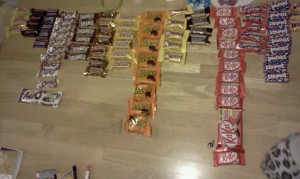Surprisingly, even toddlers and preschoolers can make a simple graph with Halloween treats–it’s easy as can be to make a bar graph using, of course, chocolate bars. (Pun fully intended.) There are other math skills and concepts that kids can develop with Halloween treats too.
 Counting is a math skill that needs lots of practice. As adults we think that’s it’s obvious the higher the number, the more the amount but kids have not yet linked each number with how many. To do this takes lots of experiences. Halloween treats can be counted in many ways. First, kids can simply count, or if they are not ready for that, they can pretend count. You could also put a small handful of only a few treats to one side and a larger handful of treats close by and ask your child which handful is more. While kids can tell just by looking which one is more, by counting them out they understand counting is used to tell about ‘more’.
Counting is a math skill that needs lots of practice. As adults we think that’s it’s obvious the higher the number, the more the amount but kids have not yet linked each number with how many. To do this takes lots of experiences. Halloween treats can be counted in many ways. First, kids can simply count, or if they are not ready for that, they can pretend count. You could also put a small handful of only a few treats to one side and a larger handful of treats close by and ask your child which handful is more. While kids can tell just by looking which one is more, by counting them out they understand counting is used to tell about ‘more’.
The bar graph is fun to do. Have kids sort out all the bar candy. Then they line up each group in rows. Which row is longer? Young kids may line up a group of bars end-to-end like a road but the bars can also be placed vertically in a column, like bricks. Now which one has more? (For kids that need more of a challenge, you can look for tricks. For instance, in the photo why is the row with Reese cups longer than the Twix? These rows have the same number.)
Another important math concept is one-to-one matching. Using two groups of different kinds of candy, kids can make partners. For instance, one bar might match with one lollipop. This creates the brain pathway for figuring out that one item goes with one number.
These are just a few of the math tricks that can be done with Halloween treats. The candies are treats for eating as well as treats for thinking and learning. What other math ideas can kids do with Halloween candy?
